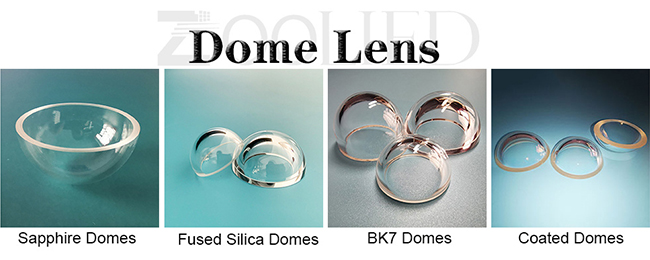Applications of Optical Dome Lens
2025-9-26

Optical Dome: The Transparent Fortress Guarding the “Visual Realm”
Across the vast applications of modern optical systems—from deep-sea exploration to space observation, from security surveillance to high-end photography—a seemingly simple yet crucial component, the optical dome, quietly serves as a “transparent fortress.” It not only acts as the first line of defense protecting the internal precision optical lenses but also plays a pivotal role in ensuring the imaging quality of the entire system.
An optical dome is a spherical or near-spherical optical window. Its core design principle lies in symmetry. Unlike flat windows, a dome does not introduce astigmatism or other off-axis aberrations when rotated around its central axis. This symmetrical structure significantly reduces light deflection at high angles of incidence, making it particularly suitable for optical systems with large field-of-view angles. It ensures that the peripheral field remains as sharp as the central field.
However, manufacturing this “transparent fortress” is an extremely challenging endeavor. Its performance hinges directly on three core technologies:
1. Materials Science and Uniformity: The selection of dome materials is paramount. It must possess high light transmittance, exceptional mechanical strength to withstand external impacts and water pressure, as well as thermal stability and corrosion resistance matching the environment. Whether sapphire glass for deep-sea applications or zinc sulfide/selenide for infrared systems, optical uniformity within the material is critical. Even minute impurities or density variations can cause wavefront distortion, severely degrading imaging quality.
2. Precision Machining and Surface Profile Accuracy: The spherical dome demands exceptionally high surface profile precision. Deviations as small as one wavelength can critically impair high-resolution imaging systems. This necessitates ultra-precision grinding and polishing techniques to achieve sub-micron accuracy and nano-level surface finish on the spherical surface.
3. High-Performance Anti-Reflection Coating: The spherical structure of the dome means light strikes at various angles, resulting in significantly higher surface reflection losses than flat windows. Therefore, high-performance anti-reflection coatings with broad spectral coverage and wide-angle incidence must be applied to both inner and outer surfaces. This coating is the core element for enhancing system transmittance and eliminating stray light interference, presenting extremely high technical challenges.
With technological advancements, the applications of optical domes continue to expand. In the future, aspherical or streamlined domes will be employed to optimize aerodynamic or hydrodynamic performance; multi-functional composite coatings will deliver smart features such as anti-fog, water-repellent, and anti-static properties; and lightweight, high-strength new materials will continually emerge.
In summary, optical domes exemplify the principle of “small components, big impact” in optical engineering. Integrating optical design, materials science, precision machining, and thin-film technology, each enhancement in their performance provides us with clearer, more reliable “eyes” for exploring the unknown.
Across the vast applications of modern optical systems—from deep-sea exploration to space observation, from security surveillance to high-end photography—a seemingly simple yet crucial component, the optical dome, quietly serves as a “transparent fortress.” It not only acts as the first line of defense protecting the internal precision optical lenses but also plays a pivotal role in ensuring the imaging quality of the entire system.
An optical dome is a spherical or near-spherical optical window. Its core design principle lies in symmetry. Unlike flat windows, a dome does not introduce astigmatism or other off-axis aberrations when rotated around its central axis. This symmetrical structure significantly reduces light deflection at high angles of incidence, making it particularly suitable for optical systems with large field-of-view angles. It ensures that the peripheral field remains as sharp as the central field.
However, manufacturing this “transparent fortress” is an extremely challenging endeavor. Its performance hinges directly on three core technologies:
1. Materials Science and Uniformity: The selection of dome materials is paramount. It must possess high light transmittance, exceptional mechanical strength to withstand external impacts and water pressure, as well as thermal stability and corrosion resistance matching the environment. Whether sapphire glass for deep-sea applications or zinc sulfide/selenide for infrared systems, optical uniformity within the material is critical. Even minute impurities or density variations can cause wavefront distortion, severely degrading imaging quality.
2. Precision Machining and Surface Profile Accuracy: The spherical dome demands exceptionally high surface profile precision. Deviations as small as one wavelength can critically impair high-resolution imaging systems. This necessitates ultra-precision grinding and polishing techniques to achieve sub-micron accuracy and nano-level surface finish on the spherical surface.
3. High-Performance Anti-Reflection Coating: The spherical structure of the dome means light strikes at various angles, resulting in significantly higher surface reflection losses than flat windows. Therefore, high-performance anti-reflection coatings with broad spectral coverage and wide-angle incidence must be applied to both inner and outer surfaces. This coating is the core element for enhancing system transmittance and eliminating stray light interference, presenting extremely high technical challenges.
With technological advancements, the applications of optical domes continue to expand. In the future, aspherical or streamlined domes will be employed to optimize aerodynamic or hydrodynamic performance; multi-functional composite coatings will deliver smart features such as anti-fog, water-repellent, and anti-static properties; and lightweight, high-strength new materials will continually emerge.
In summary, optical domes exemplify the principle of “small components, big impact” in optical engineering. Integrating optical design, materials science, precision machining, and thin-film technology, each enhancement in their performance provides us with clearer, more reliable “eyes” for exploring the unknown.

